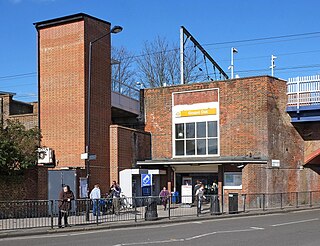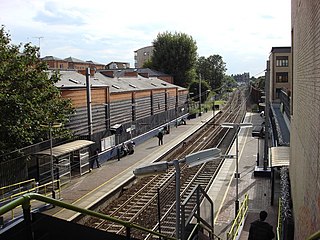
Silverlink was a train operating company in the United Kingdom owned by National Express that operated the North London Railways franchise from March 1997 until November 2007. At the end of 2007 Silverlink Metro services were taken over by London Overground and Silverlink County services were taken over by London Midland.

Highbury & Islington is an interchange station in the London Borough of Islington, north London for London Underground, London Overground and National Rail services.

The North London line (NLL) is a railway line which passes through the inner suburbs of west, north-west, north, and north-east London, England between Richmond in the south-west and Stratford in the east, avoiding central London. Its route is a rough semicircle.

Gospel Oak railway station is in the London Borough of Camden in north-west London. It is situated on the North London line, served by Mildmay line services between Clapham Junction/Richmond and Stratford, and is also the western passenger terminus of the Gospel Oak to Barking line, served by Suffragette line services to/from Barking Riverside. Passengers using Oyster cards are required to tap on interchange Oyster card readers when changing between the two lines. The station is in Travelcard Zone 2, and is managed by London Overground which runs all passenger trains at the station.
The North London Railway (NLR) company had lines connecting the northern suburbs of London with the East and West India Docks further east. The main east to west route is now part of London Overground's North London Line. Other NLR lines fell into disuse but were later revived as part of the Docklands Light Railway, and London Overground's East London Line. The company was originally called the East & West India Docks & Birmingham Junction Railway (E&WID&BJR) from its start in 1850, until 1853. In 1909, it entered into an agreement with the London and North Western Railway which introduced common management, and the NLR was taken over completely by the LNWR in 1922. The LNWR itself became part of the LMS from the start of 1923. The railways were nationalised in 1948 and most LMS lines, including the North London route, then came under the control of the London Midland Region of British Railways.

Brondesbury Park railway station is a National Rail station in Brondesbury Park in the London Borough of Brent on the North London line in Travelcard Zone 2 which is managed by London Overground. It is close to the Queen's Park area.

Camden Road railway station in the London Borough of Camden, north London, is operated by London Overground. It is on the North London line and in Travelcard Zone 2.

Caledonian Road & Barnsbury railway station in the London Borough of Islington in North London is on the North London line and is in Travelcard Zone 2. The station and all trains serving it are operated by London Overground.

Hampstead Heath railway station is in the London Borough of Camden in north London on the North London Line, between Finchley Road & Frognal and Gospel Oak stations, and is in Travelcard Zone 2. Since 11 November 2007 it and the service there have been run by London Overground. It is located on South End Road close to South End Green and Pond Street in the old South End of Hampstead.

Dalston Kingsland railway station is a railway station on the North London Line in London, England. It is in the Dalston area of the London Borough of Hackney, on the western side of Kingsland High Street and opposite Ridley Road Market. The station and all trains serving it are operated by London Overground. It is in Travelcard Zone 2. Kingsland railway station was first opened on the site in 1850, but was replaced by Dalston Junction in 1865. The current station was opened by British Rail in 1983. Ticket barriers are in operation. The station straddles the boundary with the London Borough of Islington, with part of the platforms falling within Islington.

Hackney Central is a London Overground station on the North London line in Hackney Central, north-east London. It lies between Dalston Kingsland and Homerton and is in Travelcard Zone 2. The station and all trains serving it are operated by London Overground services which are managed by Transport for London.

Gunnersbury is a London Overground and London Underground station in Gunnersbury in London, England on the North London line. The station opened on 1 January 1869 and is served by District line trains to and from Richmond, and by Arriva Rail London on the London Overground network. On the District line the station is between Turnham Green and Kew Gardens, and on the North London line it is between South Acton and Kew Gardens.

Homerton is a station on the North London line in the district of Homerton, East London. The station and all trains serving it are operated by London Overground. It is in London fare zone 2. The current station opened on 13 May 1985 to coincide with the introduction of the Richmond to North Woolwich through electric passenger service. The station is close to Homerton University Hospital and Hackney Marshes.

Canonbury railway station serves the districts of Canonbury and Highbury within the London Borough of Islington in north London. It is on London Overground's North London line and East London line. The station and all trains serving it are operated by London Overground, and the station is in Travelcard Zone 2. This location of the station is close to the boundary with the London Borough of Hackney.

Kentish Town West railway station is a railway station on the North London line and is on Prince of Wales Road in the London Borough of Camden. It is in Travelcard Zone 2. The station and all trains serving it are operated by London Overground.

Finchley Road & Frognal railway station is on Finchley Road in the London Borough of Camden in north London. It is on the North London line, and the station and all trains serving it are operated by London Overground. It is in Travelcard Zone 2. The station is about five minutes walk from Finchley Road Underground station, and is marked as an official out-of-system interchange. The station was opened as Finchley Road St Johns Wood in 1860 on the Hampstead Junction Railway for the connection to the North London Railway.

Kensal Rise is a London Overground station on the North London line on Chamberlayne Road, Kensal Rise in north-west London. The station is in Fare Zone 2.

Dalston Junction is an inter-modal rail and bus transport interchange in Dalston, London. It is located at the crossroads of Dalston Lane, Kingsland Road and Balls Pond Road. The station served by London Overground East London line and is in Zone 2. The station is located in a short section of cut and cover tunnel north of the Kingsland Viaduct.

Victoria Park was a railway station near Victoria Park, east London, that was on the North London Railway (NLR) which opened in September 1850 to Bow and to the London Docks in January 1852.

Crosstown Linkline was a railway service that operated from 14 May 1979 to 11 May 1985 between Camden Road and North Woolwich in London, England. The service was operated by British Rail with financial support from the Greater London Council. It reintroduced passenger trains to sections of line that had not been served for over thirty years. It benefited from several improvements during its brief existence as new stations were added and trains started running on Saturdays in 1983. Operated by diesel trains, it was replaced with the electric North London Link service between Richmond and North Woolwich from 13 May 1985.





















